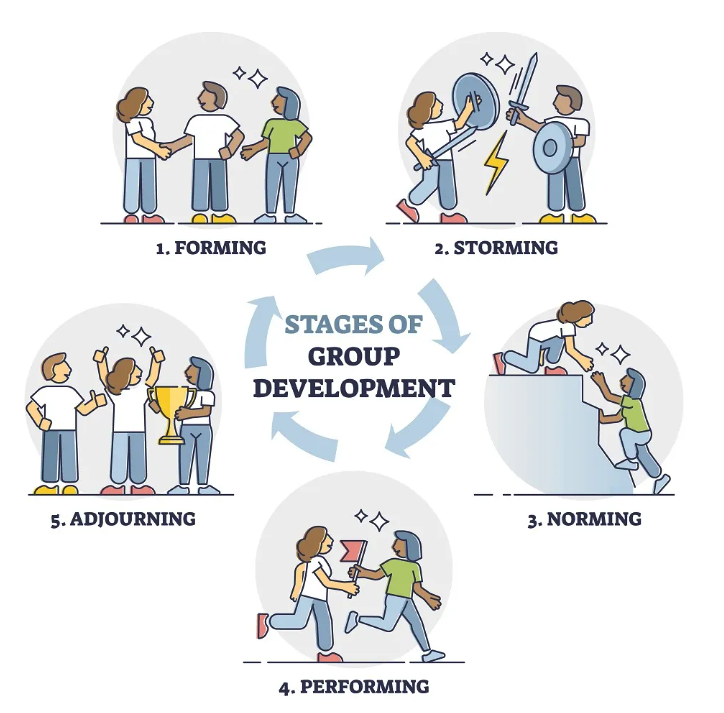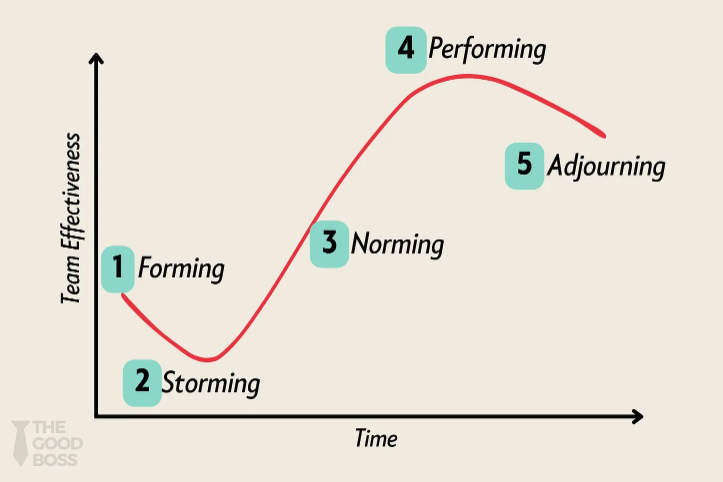The 5 Stages of Team Development: Tuckman’s Model
Author: Anna Suprun (ans@alteos.com)
Date: 12.06.2025
In our normal daily work life, one of the biggest challenges is getting a team to work effectively together. With increasing diversity across mindsets, experiences, cultures, interests, and opinions, forming a unified team can be difficult.
Team development occurs when individuals come together to form a cohesive unit. This process typically involves training, establishing clear roles and responsibilities, and learning how to collaborate productively. For a team to succeed, it must pass through several key stages of development.
Description
Social psychologist Dr. Bruce Tuckman introduced his model of team development in 1965. He originally outlined four stages teams go through as they grow and evolve. In 1977, a fifth stage was added to describe the process of disbanding the team once work is completed.
What is the Tuckman Model? The Tuckman Model is a well-established framework that describes the progression of team development over time. It explains how teams become more effective through five stages:
- Forming,
- Storming,
- Norming,
- Performing,
- Adjourning (originally referred to as “Mourning”).
These stages can be briefly summarized:
- In Forming, team members are just getting to know one another.
- In Storming, conflicts arise as differing ideas and personalities clash.
- In Norming, collaboration improves as the team develops shared norms.
- In Performing, the team reaches high efficiency and autonomy.
- In Adjourning, the team completes its work and reflects before disbanding.

1. Forming
- Team members are introduced and start getting to know one another.
- They explore each other’s strengths, weaknesses, work habits, and personalities.
- People avoid conflict and tend to “play nice” as they seek acceptance.
- The focus is on understanding objectives and establishing early expectations.
FOCUS: Clarify objectives, roles, and responsibilities.
WATCH OUT FOR: This stage can be slow and uncertain. People often delay action while gathering information, which may frustrate those eager to move forward.
2. Storming
- As members feel more secure, they begin challenging boundaries set during the forming stage.
- Clashes arise from different personalities and working styles.
- Buried irritations emerge, creating friction and impacting performance.
- Despite conflict, members begin opening up to one another.
FOCUS: The team must come together to decide how to move forwards and solve the inevitable challenges and misunderstandings. Team members are clear on their responsibilities and tasks to keep the team on track. Leaders may need to take a more directive approach to manage conflict and ensure professionalism.
WATCH OUT FOR: Some teams get stuck here. Unresolved tension can sabotage progress. Creating a safe space for diverse opinions is critical to moving forward.
3. Norming
- The team aligns on goals, timelines, and responsibilities.
- Members begin recognizing each other’s strengths and accepting weaknesses.
- Trust grows, and team members support each other more willingly.
- Storming may still happen, especially under pressure, but the team is more resilient.
FOCUS: Encourage decision-making through facilitation rather than direction. Leaders can promote social bonding to strengthen relationships.
WATCH OUT FOR: It can be difficult at this stage for concerns and new ideas to be raised, as people are keen to leave behind the uncertainty and unpleasantness of the “Storming” phase. There is a pressure to move forwards and get things done and leaders must remain open to new ideas and ensure that conflicts are aired and dealt with.
4. Performing
- The team is high-functioning and operates with clarity and purpose.
- Members follow well-established processes and need minimal supervision.
- Conflicts are handled constructively, and differing perspectives are valued.
FOCUS: Foster innovation, support autonomy, and celebrate progress and achievements.
5. Adjourning
- The task concludes, and the team prepares to be disolved.
- This stage can be emotional, especially for teams with strong bonds.
- Leaders can ease the transition by helping members reflect and prepare for future roles.
6. Lessons Learned
- If new team member joins the team at a later development stage, team moves back to the Forming stage and goes through the cycle again.
- It’s normal to have conflicts in the Storming phase and also on further stages. Difference is in the handling of the situations.
- When team is aware of 5 development stages, they can help each other to move to the next stage faster. E.g. have prepared information for new team member, ways of working, best practices, etc.
